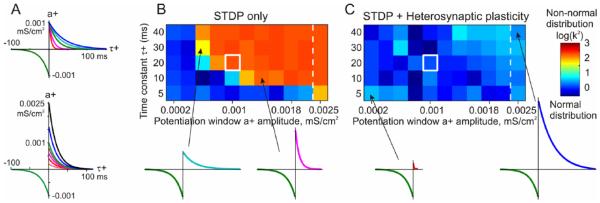Figure 5.
Heterosynaptic plasticity makes a broad range of STDP parameters compatible with stable operation of neurons. (A) Examples of STDP rules with a constant depression window (a− = 0.001 mS/cm2, τ −=20 ms), but changing the potentiation window time constant (top, τ+ = 5, 10, 20, 30, 40 ms) and amplitude (bottom, a+ = 0.2–2.5 × 10−3 mS/cm2). (B, C) Each box in the grids shows the D’Agostino-Pearson’s K2 test for normality of synaptic weight distribution after 100 seconds of simulations with different STDP potentiation windows, with a+ and τ+ as indicated on the X and Y axes. White square indicates symmetrical STDP learning rule. Synaptic weight distributions with high K2 test values (>50) indicating deviation from normality, typically contain most of the weights saturated at maximal or minimal values. Note that in simulations with STDP only model (B), only few STDP rules, with strong bias toward depression, did not lead to runaway dynamics. Most STDP rules, including examples shown in the bottom, led to runaway dynamics of synaptic weights. In contrast, model with STDP and heterosynaptic plasticity (C) did not express runaway dynamics over the whole range of tested STDP rules, including those extremely unbalanced (insets, bottom) (Modified, with permission, from Chen and others 2013b).

